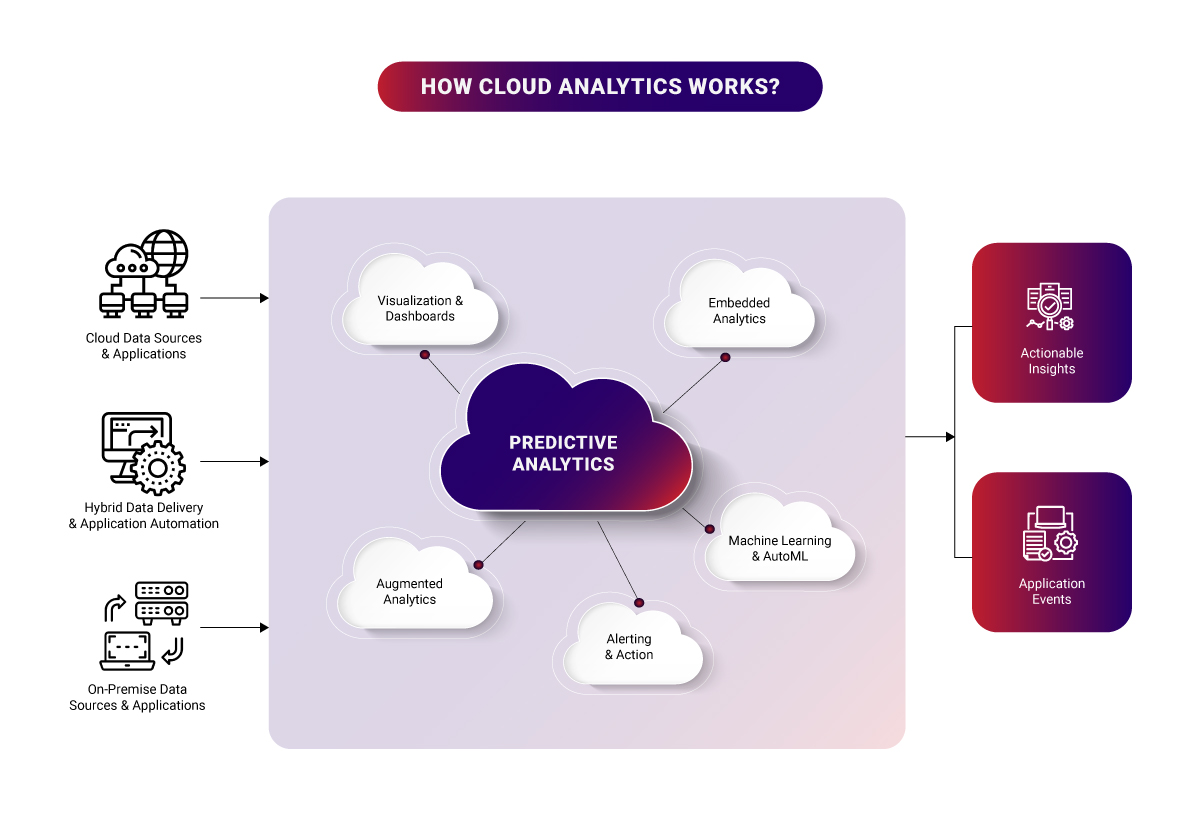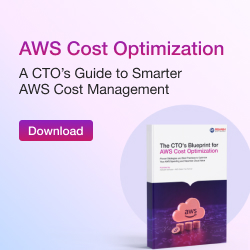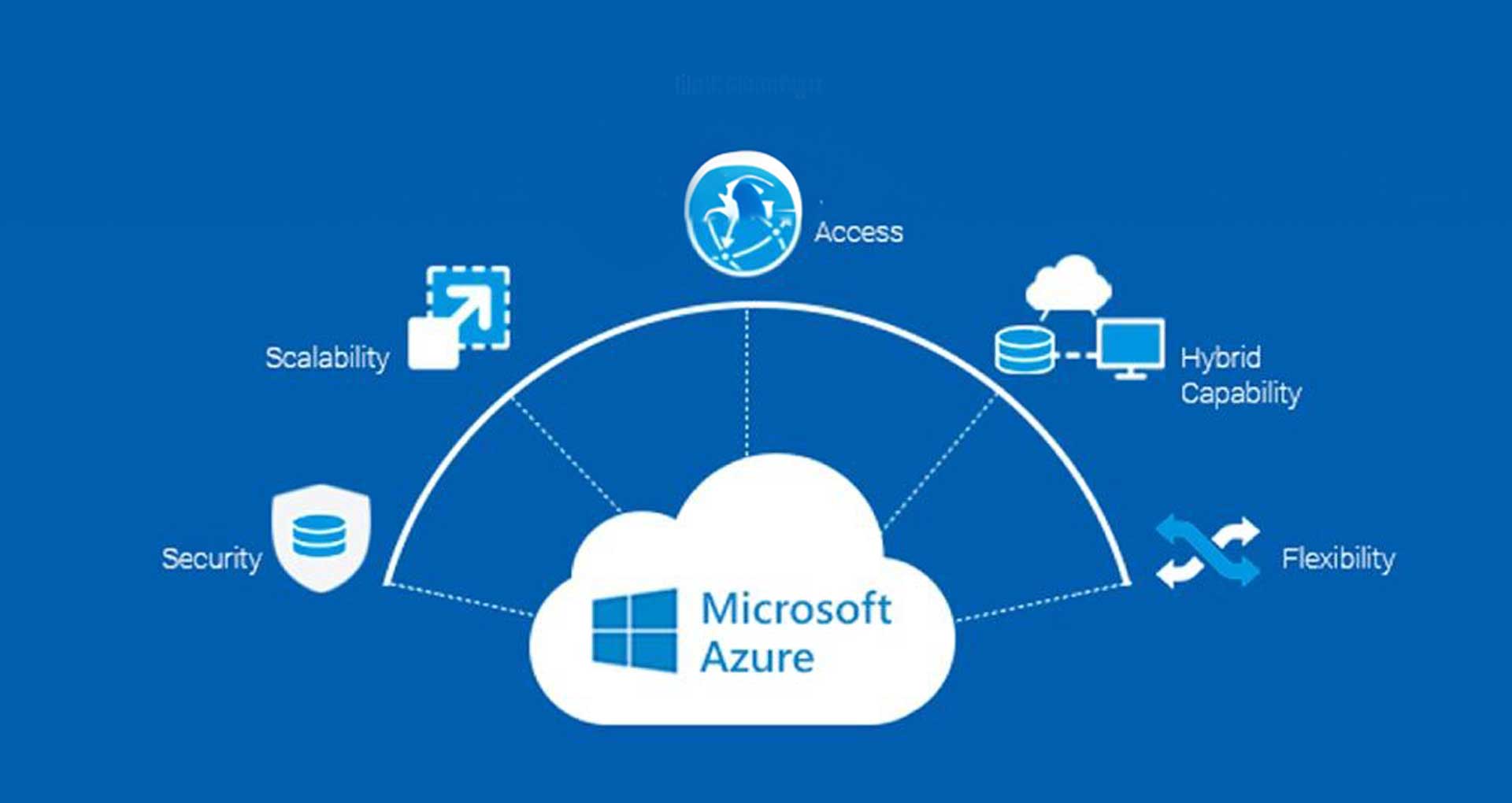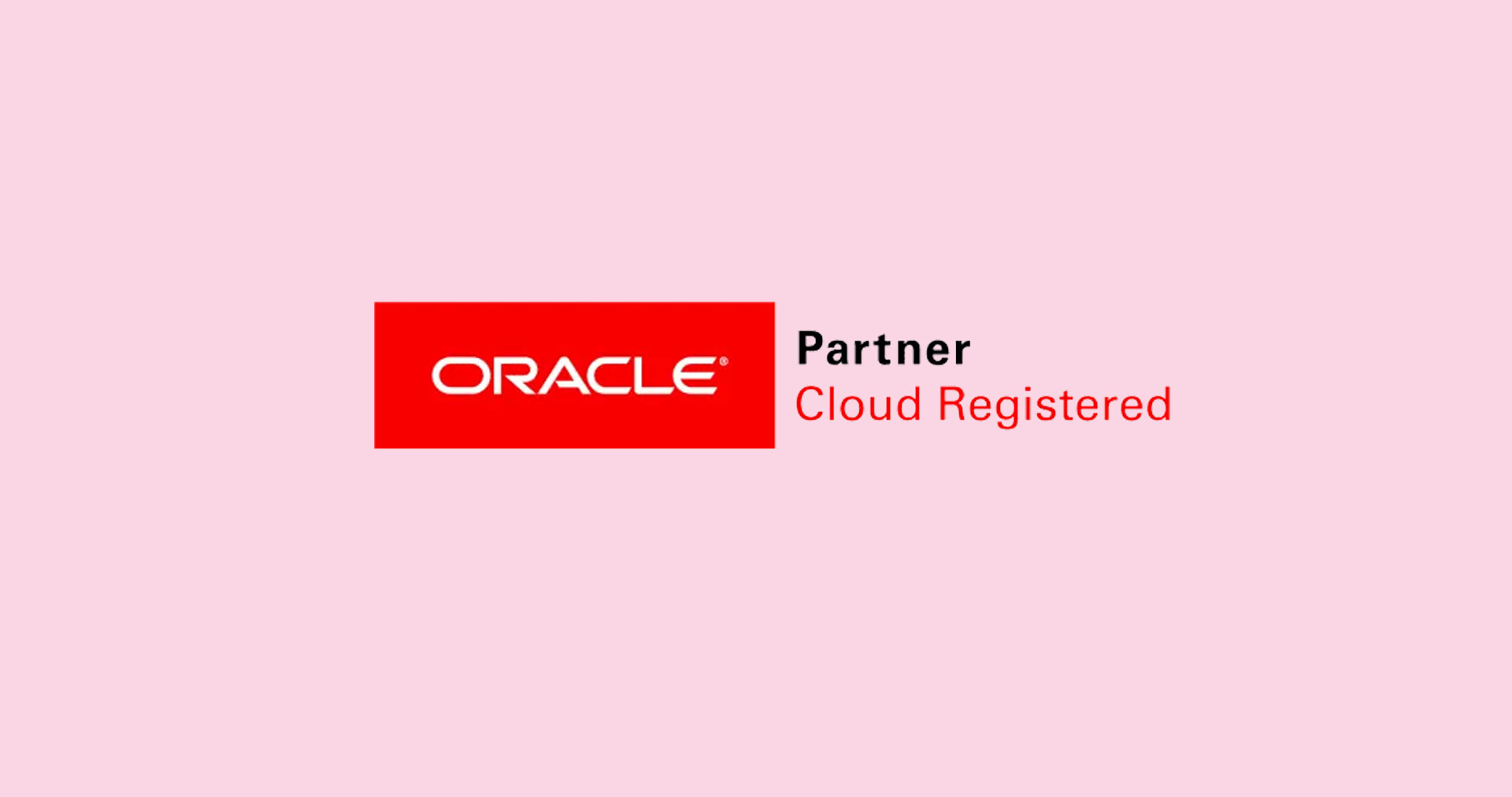Cloud Analytics is a service and delivery model that involves the deployment of cloud computing with analytics software to extract actionable insights by identifying the patterns in data. Cloud analytics is associated with Artificial Intelligence, Machine Learning, and Deep Learning. It is most commonly used across key industry applications to analyze and make sense of your business data. Whether you want to monitor production efficiency, analyze website traffic, track supply chain operations, review financial market figures, or capture real-time data from IoT sensors, cloud analytics has got you covered.
Let’s discover in detail what cloud data analytics is and why it matters. We will also explore how cloud-based data analytics work, the advantages of cloud analytics, and valuable tips on selecting the right platform in this insightful blogpost. Uncover the power of leveraging your data to extract valuable insights, make accurate predictions, and take proactive actions that were once mere aspirations.
How Does Cloud Data Analytics Drive Business Growth and Efficiency?
Data analytics has been around for a while, evolving with emerging technologies. As analytics moved to the cloud, it became Cloud Data Analytics, offering easier, more accessible, and capable data analysis on large datasets.
Why Use Cloud Analytics?
- The global data volume is growing rapidly, with much of it residing in the cloud or IoT endpoints.
- Cloud analytics services are easy to deploy & automated and require no physical hardware maintenance.
- Cloud’s consumption-based model lets users pay for what they use, eliminating the need for capital infrastructure procurement and reducing data center space.
- Dynamic resource allocation enables users to adjust compute and storage resources as needed, avoiding fixed capacity requirements.
- A hybrid analytics solution allows testing new projects in the cloud before committing to on-premises investments.
Cloud Data Analytics Empowers Organizations to;
- Enhance customer satisfaction and service by identifying patterns in speech, images, and videos.
- Optimize product availability and delivery through buying behavior analysis.
- Improve medicine and vaccine availability by studying disease reporting patterns.
- Enhance application performance and optimize IT costs by analyzing hybrid cloud infrastructures.
The Cloud Analytics Market: Size, Share & Growth Trends
By 2028, the cloud analytics market is predicted to reach a staggering USD 86.15 Billion, growing at a compound annual growth rate (CAGR) of 20.9% during 2021-2028[1].
So, What’s Driving the Growth?
- A few key factors are contributing to the rise of cloud analytics. Integrating analytics solutions into cloud based data analytics platform allows companies to gain greater control over business operations and stay competitive. Our data and analytics consulting services can assist in seamlessly integrating these solutions to optimize your business performance.
- The increasing availability of data connectivity through multi-cloud and hybrid environments and the growth of big data technology are some of the major factors driving the development of the global market.
- Cloud analytics is a service model that covers business intelligence or data analytics conducted on a private or public cloud to minimize the expense and maintenance costs of on-premises data storage and computation.
As businesses continue to recognize the benefits of integrating analytics in the cloud, we expect continued investment and innovation.
How Cloud Analytics Works?
Vendors manage data analytics and business intelligence (BI) processes in cloud-based data analytics instead of relying on your company’s on-premise servers. This arrangement is often referred to as “analytics as a service.” The analytics vendor assumes responsibility for setup and maintenance, simplifying the process of extracting deep data insights. This approach offers scalability, improved performance, reliability, and cost savings.

Let’s break down the diagram above to help you understand how data is processed by cloud analytics into actionable insights and application events.
The Process Explained
- Data Sources: Data originates from both cloud-based and on-premises sources and applications. Cloud-based data analytics platforms are designed to handle hybrid data delivery and application automation efficiently. Examples of data sources include transactional, website usage, social media, and CRM portal data.
- Cloud Data Warehousing: Data is typically stored in a cloud data warehouse, managed by market-leading vendors such as Amazon Redshift, Google BigQuery, Microsoft Azure, or Snowflake.
- Cloud-based Analytics Tools: These tools leverage the stored data to enable decision-makers with diverse analytics capabilities. This includes creating visualizations, interactive dashboards, and cloud-based reporting. The best tools extend their functionality to integrate advanced analytics, predictive analytics, Machine Learning, and automated machine learning (AutoML). They also allow for the integration of analytics into other applications and facilitate triggering alerts and notifications in other systems.
This wide range of analytics capabilities enables pattern recognition and the development of actionable insights, which can lead to increased efficiency, productivity, and profits. Additionally, top-tier tools offer seamless integration with other applications to initiate automated, data-driven events.
Types of Cloud Analytics
Cloud based analytics involves conducting data analysis and related processes (data integration, aggregation, storage, and reporting) fully or partially in the cloud. There are three distinct types of cloud analytics. Your choice among them will depend on your budget, business requirements, and compliance needs.
#1. Public Cloud
Public cloud in this category is referred to as application as a service, including virtual machines, storage, and data processing. These services are available to the general public and operate on a multi-tenant architecture, where IT systems are shared, but data remains isolated. This setup allows companies to reduce costs and streamline IT management.
#2. Private Cloud
A private cloud is a proprietary cloud that exclusively extends your organization’s existing IT infrastructure. Private clouds are implemented when data privacy and security are top priorities, although they typically have higher implementation costs.
#3. Hybrid Cloud
Hybrid cloud combines the elements of both public and private clouds. These implementations enable organizations to enjoy the benefits of on-demand IT infrastructure for non-sensitive data while maintaining sensitive data within a private cloud environment.
Key Benefits of Cloud Analytics
Any industry can benefit from data analytics to enhance performance and create value. Leveraging AI and analytics allows organizations of all sizes to make data-driven decisions quickly. The cloud facilitates experimentation and offers a rich software ecosystem for building AI applications and training deep learning models. It is the future of data analysis, offering businesses numerous benefits, including the following.
- Scalability: Cloud-based data analytics solutions quickly adapt to your business’s growth or retrenchment. This flexibility is unmatched by on-premise alternatives.
- Accessibility and Collaboration: Cloud solutions provide 24/7 access from any device, promoting easy data access. Collaboration features facilitate secure data sharing with colleagues and clients.
- Pay-As-You-Go Model: This flexibility frees you from the hassles of hefty upfront payments and long-term contracts, making it an ideal solution for businesses operating on a budget.
- Data Consolidation: Cloud solutions offer tools to centralize data from various sources, simplifying and accelerating understanding and analysis.
- Cost Savings: Transitioning from on-premises to cloud analytics can save significant costs, especially for large data analysis tasks.
- Easy Deployment and Maintenance: Cloud providers handle infrastructure management, requiring minimal effort from you.
What Are the Top Cloud Analytics Tools?
Here’s a list of top cloud-based analytics tools with various features and capabilities that make them suitable for a range of business needs:
- Microsoft Azure Analytics
- Azure Synapse Analytics is a cloud-based analytics service for big data and data warehousing.
- Power BI is a suite of business analytics tools for data visualization and sharing insights.
- Amazon Web Services (AWS) Analytics
- Amazon Redshift: A fully managed data warehouse service.
- Amazon QuickSight: A business intelligence service for creating interactive dashboards.
- Google Cloud Platform (GCP) Big Data and Analytics
- BigQuery: A fully managed, serverless, and highly scalable data warehouse.
- Data Studio: A free, powerful data visualization and reporting tool.
- Snowflake
- Snowflake Data Cloud: A platform for data warehousing, data lakes, data engineering, data sharing, and data applications.
- Tableau Online
- A leading data visualization and business intelligence tool that works seamlessly in the cloud.
- Databricks
- Unified analytics platform for big data and machine learning.
- QlikView
- A data visualization and business intelligence tool that helps users make data-driven decisions.
- Sisense
- A business intelligence software platform with embedded analytics capabilities.
From data warehousing and visualization to advanced analytics and machine learning – these modern cloud analytics tools come with a wide range of capabilities. You can consider the following options to find the one that best suits your business requirements for data analysis in the cloud.
Popular Types of Cloud Analytics Tools
When it comes to cloud based analytics tools, there are several popular types, each serving specific purposes as listed below:
- Business Intelligence Tools: These tools focus primarily on data visualization, intuitive dashboards, and reporting to help businesses gain accurate insights from their data. Preferred examples include Tableau, Power BI, and Looker.
- Data Warehousing Solutions: Data warehousing tools, manage, and analyze large datasets. Amazon Redshift, BigQuery, and Azure Synapse Analytics fall into this category.
- Data Integration and ETL (Extract, Transform, Load) Tools: ETL helps to extract data from various sources, transform it into a suitable format, and load it into a data warehouse or analytics platform. Apache NiFi, Talend, and Apache Spark are popular choices.
- Machine Learning and AI Platforms: These tools enable businesses to build and deploy machine learning models for predictive analytics. Databricks and IBM Cloud Pak for Data are examples in this category.
- Data Visualization Tools: These tools create visually appealing and interactive data representations. They include tools like Tableau, Looker, and Data Studio.
- Data Preparation Tools: Data preparation tools assist in cleaning, transforming, and preparing data for analysis. Alteryx and Trifacta are well-known solutions.
- Streaming Analytics Tools: Streaming analytics platforms process and analyze data in real-time, making them suitable for applications like IoT and event-driven analytics. Apache Kafka and Apache Flink are examples.
- Cloud-Native Analytics Tools: Some tools are designed specifically for the cloud, offering scalability, flexibility, and cost-effectiveness. Snowflake and QlikView are notable options.
These categories cover a wide spectrum of modern cloud analytics platforms, each tailored to meet different data analysis needs. Let’s understand how to choose the analytics platform that best aligns with your goals and data requirements.
How to Choose the Right Cloud Analytics Platform?
Cloud-based data analytics platforms are designed to handle and analyze vast datasets, making them essential for businesses dealing with extensive datasets. These platforms typically employ machine learning algorithms to automate data analysis while also allowing users to apply their algorithms manually. Here are key factors to narrow down your choice for sustainable success:
- Data Mining and Analysis Capabilities: Assess the platform’s ability to efficiently mine through large datasets by conducting tests with a sample database to ensure it meets your data processing requirements.
- Scalability: Ensure that the chosen platform can grow alongside your business. Seek flexible pricing plans that allow you to pay only for the resources you use as your needs evolve.
- Security: Prioritize data security. Opt for a platform that employs encryption for data both “in transit” and “at rest” to safeguard sensitive information.
- Real-time Integration: Select a cloud analytics platform that seamlessly integrates with your organization’s other systems in real-time. This ensures your company stays up to date effortlessly without additional effort.
- Data Visualization: Opt for a platform that offers a variety of data visualization options. It should present structured and unstructured data in an easily understandable format, even for non-technical users.
- Tailored Analytics: Every company relies on unique business metrics. Look for a cloud analytics platform capable of calculating and accommodating your specific metrics and reporting needs.
- Responsive Interface: Given the increasing use of data analysis on mobile devices, ensure that your chosen platform offers a responsive and user-friendly interface that won’t slow down on users’ smartphones and other devices.
While cloud analytics tools are often associated with larger companies with extensive databases, even smaller businesses can benefit significantly. Leveraging cloud analytics eliminates the need for in-house IT personnel and other staff members tasked with manual data analysis, freeing up time and resources for more critical business activities.
Challenges of Cloud Analytics and How to Solve Them
While cloud analytics solution providers often tout their solutions and services’ reliability, features, and capabilities, businesses remain vulnerable to challenges. Listed below are a few common pitfalls with their practical solutions to help you make the most of cloud analytics while minimizing potential disruptions.
#1 Performance
Cloud analytics can face downtimes, so you must consider vendors with high uptime rates.
Solution: To ensure uninterrupted operations, consider a hybrid cloud strategy that combines on-premises and cloud analytics.
#2 Data Security
Data loss and leakage are concerns with cloud adoption.
Solution: Enhance data security by investing in employee training and certifications, reducing vulnerabilities.
#3 Finding the Right Skillsets
Hiring and training for cloud analytics can be challenging due to ever-evolving technology.
Solution: Reduce skill gaps using automation tools and invest in skill development initiatives.
#4 Managing Cost
Cloud analytics costs can spiral if not monitored carefully.
Solution: Avoid cost overruns by implementing cost monitoring strategies and automation. Regularly review expenses for optimization.
#5 Legacy Systems
Migrating outdated systems to the cloud is tedious, time-consuming, and risky.
Solution: Minimize migration risks by planning thoroughly, ensuring secure data backups, and seeking the guidance of a technology partner when needed.
How Rishabh Software Can Help You Put Your Cloud Data to Work?
Being an industry leader in data analytics services, our expertise lies in converting your data into BI dashboards and connecting any business data source to minimize reliance on manual data feeds. We place the utmost importance on your reporting needs by meticulously defining data sources, data flows, and the precise functions of each component.
Our team has extensive experience with popular BI platforms such as Power BI and Tableau. We can assist you in migrating your existing reports from Excel & Tableau to Power BI. Our profound understanding of cloud service platforms like AWS (Amazon Web Services) & Microsoft Azure allows us to harness the power of cloud analytics for data visualization. With us, you can be confident that your data analytics project is in capable hands.
Frequently Asked Questions
Q: What is Cloud Analytics?
A: Cloud Analytics refers to a type of data analysis that shifts the elements of data analytics, such as data processing and storage operations, to a public or private cloud. Like on-premises data analytics, cloud analytics solutions help you identify patterns, make predictions, and derive actionable insights. It extends those capabilities to enable you to work with massive amounts of complex business data using algorithms and cloud technologies.
Q: What is the Difference Between Cloud Analytics and Data Analytics?
A: Data analytics relies on IT infrastructures to store, process, and model incoming data streams swiftly, while a cloud platform provides scalable storage, computing, and network bandwidth for big data apps. So, cloud and data analytics are two interconnected fields that complement each other. The key difference between them is that data analytics depends on cloud computing for data extraction, whereas cloud computing doesn’t depend on data analytics for anything.
Q: Which Features are Included in a Cloud Analytics Tool?
A: Cloud Analytics Tool is a platform based in the cloud that allows the user to view analytics data. You can monitor data sources, data models, processing applications, computing resources, analytics models, and storage resources. These tools carry out a variety of data analytics use cases, such as streaming analytics, predictive analytics, cloud reporting, and dashboards into other applications and systems.
Footnotes:
1. https://www.fortunebusinessinsights.com/cloud-analytics-market-102248












 30 Min
30 Min


